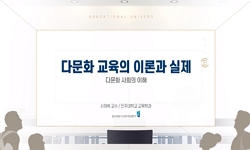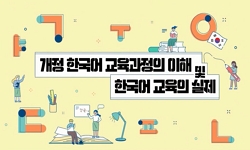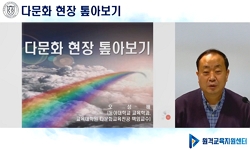This study analyzed the 5th and 6th grade physical education textbook illustrations in accordance with the 2015 revised curriculum in three aspects: gender equality education, multicultural education, and integrated education for students with disabil...
http://chineseinput.net/에서 pinyin(병음)방식으로 중국어를 변환할 수 있습니다.
변환된 중국어를 복사하여 사용하시면 됩니다.
- 中文 을 입력하시려면 zhongwen을 입력하시고 space를누르시면됩니다.
- 北京 을 입력하시려면 beijing을 입력하시고 space를 누르시면 됩니다.
2015 개정 교육과정에 따른 5, 6학년 체육교과서 삽화 자료의 불평등 요인 분석 = An Analysis of Inequality Factors in the Illustrations of Physical Education Textbooks for 5 and 6 Grade Based on the 2015 Revised National Curriculum
한글로보기https://www.riss.kr/link?id=T16854730
- 저자
-
발행사항
서울 : 서울교육대학교 교육전문대학원, 2023
-
학위논문사항
학위논문(석사) -- 서울교육대학교 교육전문대학원 , 초등체육교육 초등체육교육 , 2023. 8
-
발행연도
2023
-
작성언어
한국어
- 주제어
-
발행국(도시)
서울
-
형태사항
112 ; 26 cm
-
일반주기명
지도교수: 김방출
-
UCI식별코드
I804:11031-200000696241
- 소장기관
-
0
상세조회 -
0
다운로드
부가정보
다국어 초록 (Multilingual Abstract)
This study analyzed the 5th and 6th grade physical education textbook illustrations in accordance with the 2015 revised curriculum in three aspects: gender equality education, multicultural education, and integrated education for students with disabilities, to find out the inequality factors inherent in them. A total of 16 textbooks of 8 types were analyzed and the study was conducted. Among the seven analysis criteria of Sadker, D & Sadker, M., scarcity and stereotypes that are easy to analyze illustrations in physical education textbooks were selected as analysis criteria to set up the analysis framework, and these analysis frameworks were used for gender equality education, multicultural education, and students with disabilities. The existence of inequality factors was analyzed by combining it with the perspective of integrated education. A total of 16 types of textbook illustrations were classified based on the established analysis framework and quantified using the Microsoft-Excel program. Based on this, the inequality factors in the three perspectives revealed in the 5th and 6th grade physical education textbooks are as follows.
First, looking at the male to female ratio among character illustrations from the perspective of gender equality education, the male to female ratio was 1.09:1 in the 5th grade and 1.12:1 in the 6th grade, showing a male bias. As for the gender ratio by domain, the ratio of men was high in the four domains of health, challenge, competition, and safety, and the ratio of women was high in the expression domain, showing female bias only in the expression domain. Among the character illustrations, the ratio of male and female who played the leading role was high in all 16 textbooks for 5th and 6th graders, and the ratio of co-starring illustrations was high, suggesting that gender equality education has progressed to a fairly equal relationship compared to past research results. Could know. However, when only male and female heroine illustrations were considered, the ratio of male protagonist illustrations was high, excluding the ratio of co-star illustrations. In addition, the male to female ratio of adult occupations was 1.89:1 for 5th graders and 1.32:1 for 6th graders, showing a high male ratio. In particular, jobs such as soccer players, volleyball players, and lifeguards were mostly male, while figure skaters and cultural commentators were all female, so there was a possibility that they could be considered as suitable gender depending on the job. Nonetheless, it can be said to be quite encouraging in that there are many parts where the writers of each textbook have meticulously worked hard for a balanced harmony of both sexes in 16 textbooks.
Second, illustrations related to multicultural physical education were 44 in 5th grade and 0 in 6th grade, showing an imbalance by grade. Among the figure illustrations, the ratio of illustrations including multicultural students was 2% in 5th grade and 3.3% in 6th grade, slightly lower than the ratio of multicultural students in the actual field. In particular, two publishers did not publish even a single illustration of multicultural students. Multicultural students often took a leading role in illustrations featuring multicultural students, because there were many illustrations in which they were co-stars. However, there were no illustrations featuring multicultural students alone. The male to female ratio of multicultural students was 1.02:1, which was an appropriate ratio.
Third, not a single illustration related to special physical education appeared in all 16 types of physical education textbooks for 5th and 6th graders. The percentage of students with disabilities was 0.1% in the 5th grade and 0.4% in the 6th grade, with 7 students with disabilities appearing in a total of 3 types of textbooks, and no students with disabilities appearing in 13 types of textbooks. In the 5th grade textbook, one disabled student appeared, but he played a non-leading role, and in the 6th grade textbook, a total of 6 disabled students appeared in illustrations, of which 5 were playing a leading role. Looking at the gender ratio of students with disabilities, it was not possible to calculate the ratio because there was only one illustration in which a student with a disability appeared in the 5th grade, and the character was also a male student. In the 6th grade, there were twice as many female students as 0.50:1. The proportion of students with disabilities as female rather than male was higher. The perspective of students with disabilities reflected in textbooks was regarded as the same students as normal students, not objects of sympathy. As for the type of disability, 100% were physically handicapped in a wheelchair. In the future revised curriculum, more students with various disabilities should appear, reflecting the reality that 5.13% of the total population has a disability (Ministry of Education, 2022).
As a result of analyzing the 5th and 6th grade physical education textbook illustrations in accordance with the 2015 revised curriculum from three aspects: gender equality education, multicultural education, and integrated education for students with disabilities, the gender equality education perspective among the three aspects stands out as a social issue. A lot of related research has been conducted, and although there are still some shortcomings, they are moving toward a fairly equal figure. However, in the perspective of multicultural education, despite the fact that multicultural students are rapidly increasing by more than 5 times in 10 years in line with the decrease in the school-age population (Ministry of Education, 2022), the number of character illustrations is far less than the reality. Inclusive education for students with disabilities was the most unsatisfactory among the three aspects. 5th and 6th grade textbooks did not include a single illustration related to special physical education, and publishers who did not feature students with disabilities in textbook illustrations accounted for 13 out of 16 textbooks for 5th and 6th graders, a situation that requires attention before change. am. As the registered disabled population in Korea accounts for 5.13% of the total population, there is a need to strengthen integrated education elements in textbooks.
Based on the analysis of inequality factors in the 5th and 6th grade physical education textbooks in the 2015 revised curriculum, it is necessary to write a more balanced textbook from the perspectives of gender equality education, multicultural education, and inclusive education for students with disabilities in the 2022 revised curriculum.
국문 초록 (Abstract)
본 연구는 2015 개정 교육과정에 따른 5, 6학년 체육교과서 삽화 자료를 양성평등교육, 다문화교육, 장애학생 통합교육의 세 가지 측면에서 분석하여 그 속에 내재된 불평등 요인을 알아보고...
본 연구는 2015 개정 교육과정에 따른 5, 6학년 체육교과서 삽화 자료를 양성평등교육, 다문화교육, 장애학생 통합교육의 세 가지 측면에서 분석하여 그 속에 내재된 불평등 요인을 알아보고자 5, 6학년 각 8종, 총 16종의 교과서를 분석 대상으로 하여 연구를 진행하였다. Sadker, D & Sadker, M.의 7가지 분석기준 중 체육교과서 삽화 분석에 용이한 희소성과 고정관념을 분석준거로 선택하여 분석틀을 설정하였고, 이러한 분석틀을 양성평등교육, 다문화교육, 장애학생 통합교육이라는 관점과 접목시켜 불평등 요인의 존재 여부를 분석하였다. 설정한 분석틀을 근거로 총 16종의 교과서 삽화를 분류하였으며 Microsoft-Excel 프로그램을 이용하여 수치화하였다. 이를 근거로 5, 6학년 체육교과서에 드러난 세 가지 관점에서의 불평등 요인은 다음과 같다.
첫째, 양성평등교육 관점에서 인물삽화 중 남, 여 성비율을 살펴보면 5학년은 1.09:1, 6학년은 1.12:1로 남성 비율이 높아 남성편향성을 보였다. 영역별 성비율은 건강, 도전, 경쟁, 안전의 4가지 영역에서 남성의 비율이 높았고, 표현영역은 여성 비율이 높아 표현 영역에서만 여성편향성이 나타났다. 인물삽화 중 주연을 맡은 남녀 성비율은 5, 6학년 16종의 교과서 중 16종 모두에서 공동주연삽화 비율이 높아 양성평등교육 관점으로 볼 때 과거의 연구 결과들에 비해 상당히 평등한 관계로 진전되었음을 알 수 있었다. 다만 공동주연삽화 비율을 제외한 남, 여 주인공 삽화 비율만을 고려했을 때에는 남성주인공 삽화 비율이 높았다. 또한 성인 직업인 남녀의 성비는 5학년 1.89:1, 6학년 1.32:1로 남성의 비율이 높은 것으로 나타났다. 특히 축구선수, 배구선수, 안전요원 등의 직업에 주로 남성이 배치되어 있었고 피겨스케이트 선수, 문화해설사는 전부 여성이 배치되어 있어 직업에 따라 적합한 성(性)이 있는 것으로 간주될 가능성이 있었다. 그럼에도 불구하고 16종의 교과서 곳곳에는 각 교과서 집필진들이 양(兩)성의 균형있는 조화를 위해 세심히 애쓴 부분이 많았다는 점에서 상당히 고무적이라 할 수 있다.
둘째, 다문화 체육교육 관련 삽화는 5학년 44개, 6학년 0개로 학년별 불균형 양상을 보였다. 인물 삽화 중 다문화 학생을 포함한 삽화 비율은 5학년 2%, 6학년 3.3%로 실제 현장에서 다문화 학생들이 차지하고 있는 비율보다 다소 낮았다. 특히 2개 출판사는 다문화 학생 삽화가 한 컷도 실리지 않았다. 다문화 학생 등장 삽화에서 다문화 학생이 주도적 역할을 맡는 경우가 많았는데 이는 공동주연인 삽화가 많았기 때문이다. 다만 다문화 학생 단독 주연인 삽화는 없었다. 다문화 학생 남녀 간 성비는 1.02:1로 적당한 비율을 이루고 있었다.
셋째, 특수체육교육 관련 삽화는 5, 6학년 총 16종의 체육교과서를 통털어 단 한 개의 삽화도 등장하지 않았다. 장애 학생 비율은 5학년 0.1%, 6학년 0.4%로 총 3종의 교과서에 장애 학생 7명이 등장했고 이를 제외한 13종의 교과서에서는 장애 학생이 한 명도 등장하지 않았다. 5학년 교과서에는 1명의 장애 학생이 등장했는데 비주도적 역할이었고, 6학년 교과서에는 총 6명의 장애 학생이 삽화에 실렸는데 그 중 5명이 주도적 역할을 하고 있었다. 장애 학생의 성비율을 보면 5학년은 장애 학생이 등장한 삽화가 하나 뿐이고 등장인물 또한 남학생 한 명이라 비율을 산정할 수 없었다. 6학년은 0.50:1로 여학생이 2배 많은 것으로 나타났다. 장애 학생을 남성보다는 여성으로 나타낸 비율이 높았다. 교과서에 비추어진 장애 학생에 대한 관점은 동정의 대상이 아닌 일반학생과 동일한 학생으로 간주되어 있었다. 장애의 유형은 휠체어를 탄 지체장애인이 100%를 차지했다. 향후 개정 교육과정에서는 다양한 장애의 모습과 함께 더 많은 장애 학생이 등장하여 전 인구의 5.13%가 장애를 가지고 있는 현실(교육부, 2022)을 반영해야 한다.
2015 개정 교육과정에 따른 5, 6학년 체육교과서 삽화 자료를 양성평등교육, 다문화교육, 장애학생 통합교육의 세 가지 측면에서 분석하여 본 결과 3가지 측면 중 양성평등교육 관점은 사회적인 이슈로 크게 부각이 되기도 했고 관련 연구도 많이 진행되어 아직 미흡한 점은 있지만 상당히 평등한 모습으로 나아가고 있었다. 그러나 다문화교육 관점은 학령기 인구의 감소와 맞물려 다문화 학생이 10년 사이에 5배 이상 가파르게 증가하고 있는 현실(교육부, 2022)에도 불구하고 등장인물 삽화 수가 현실에 비해 많이 부족하게 표현되어 있었다. 장애학생 통합교육은 세 측면 중 가장 미흡했다. 5, 6학년 교과서에 특수체육교육 관련 삽화가 단 한 컷도 포함되어 있지 않았고, 장애학생을 교과서 삽화에 등장시키지 않은 출판사도 5, 6학년 16종 교과서 중 13종이나 되어 변화 이전에 관심부터 필요한 실정이다. 우리나라의 등록 장애인 인구가 총인구수 대비 5.13%를 차지하는 만큼 교과서 내에 통합교육 요소를 더욱 강화할 필요성이 있다.
2015 개정 교육과정 5, 6학년 체육교과서 삽화 자료의 불평등 요인에 대한 분석을 바탕으로 2022 개정 교육과정에는 양성평등교육, 다문화교육, 장애학생 통합교육의 관점에서 보다 균형잡힌 시각의 교과서가 집필될 필요가 있다.
목차 (Table of Contents)
- Ⅰ. 서론 1
- 1. 연구의 필요성 및 목적 1
- 2. 연구 문제 3
- 3. 용어의 정의 4
- 4. 연구의 제한점 5
- Ⅰ. 서론 1
- 1. 연구의 필요성 및 목적 1
- 2. 연구 문제 3
- 3. 용어의 정의 4
- 4. 연구의 제한점 5
- Ⅱ. 이론적 배경 6
- 1. 2015 개정 교육과정 6
- 2. 평등교육 9
- 3. 체육교과서와 삽화자료 17
- 4. 선행연구 19
- Ⅲ. 연구 방법 25
- 1. 분석 대상 25
- 2. 연구 절차 26
- 3. 분석 기준 및 관점 26
- 4. 분석 방법 및 절차 32
- Ⅳ. 연구결과 및 논의 36
- 1. 양성평등교육 관점의 불평등 요인 36
- 2. 다문화교육 관점의 불평등 요인 67
- 3. 장애학생 통합교육 관점의 불평등 요인 75
- Ⅴ. 결론 및 제언 83
- 1. 결론 83
- 2. 제언 89
- 참고문헌 91
- ABSTRACT 96












